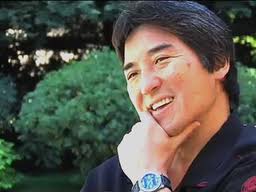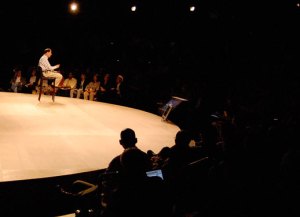Guy Kawasaki . . . Genius in Action Part 3,
By Sam Horn, The IntrigueExpert
This is the final post detailing the excellence in action that Guy Kawasaki demonstrated during his keynote for Ruth Stergiou’s Invent Your Future Conference in NoCA.
Actually, there were many more things Guy did extraordinarily well . . . however these blog posts are already long enough.
Want to know what I suggest? Go see Guy in person if you have a chance.
I am a firm believer that our personal and professional impact is directly proportionate to our ability to communicate compellingly and convincingly.
If you’d like to turn no’s into yes’s – if you’d like to win buy-in from the people who have the power to scale your career, buy your products or services or support your message and mission – do yourself a favor and study great communicators like Guy (on the stage) and Seth Godin (on the page).
Then, adopt and adapt (don’t copy) their masterful approaches so you too know how to capture and keep everyone’s attention and respect – from start to finish.
7. Guy featured a kaleidoscopic mix of reference points.
“Let’s give em something to talk about.” – Bonnie Raitt
Hmmm. Let’s see. Grateful Dead. Check. Steve Jobs. Check.
Personal examples. Professional examples. Check. Check.
United States anecdotes. International anecdotes. Yep.
Fortune 500 success stories. Small business success stories. Yep. Yep.
Some speakers commit the cardinal sin of focusing solely on a few “favorites.” sports. Kids. Corporate life. That leaves some people out. They may not like sports, don’t have kids or work for themselves.
Guy gave everyone something to “talk about.” By using a wide range of “demographically-correct” reference points, he made sure everyone felt included, honored and acknowledged.
The eclectic mix kept us eager for what’s next. Novelists call this a page-turner. The speaker equivalent is a “seat-edger,” as in, “We were on the edge of our seats the whole time.”
One of the most effective ways Guy modeled this was by using “pulled from the headlines” or “signs on the street” slides to prove his points.
For example, he mentioned he was just in New England checking out colleges with his kids. To illustrate how “disenchantment” can be caused by overcomplicating things, he popped up a Smartphone photo showing a sign from an Ivy League university campus that went into great detail on how to . . . (wait for it) cross the street.
Embedding his point in a recent, first-person story lent instant credibility to his case because it had currency. This isn’t
tired shtick – it just occurred yesterday or last week.
And he did this with EACH of his points – providing a “couldn’t see it coming” reference that explored the point in a compelling, convincing and creative way.
If you’re about to give a presentation, go back over your planned remarks. Double check that you have balanced gender, age, ethnic, work-life, geographic and industry diversity.
And, hold up a prop! Make it show not tell. Sharing an article from THAT day’s newspaper that’s relevant to your topic will charm your audience and turn “blah-blah-blah” into “rah-rah-rah.”
8. Guy was in his “Tony Bennett” zone.
“I have found if you love life, life will love you back.” – Arthur Rubenstein
Have you ever had the distinct privilege of seeing and hearing Tony Bennett in concert? If not, do yourself a favor and grab a ticket for his next concert in your area.
Tony Bennett is the consummate entertainer. Not just because he has a voice like “butta” and not just because he’s a great song stylist.
It’s because Tony Bennett LOVES HIS AUDIENCE . . . and isn’t afraid to show it. When singers (or speakers) love what they’re doing, we love ‘em back.
Tony may have sung I Left my Heart in San Francisco a thousand times but you’d never know it. He gifts each audience by singing that song as if for the first time.
What many speakers don’t understand is that our audiences will feel the way we feel.
We won’t have fun if you’re not having fun. If you’re not happy to be up there – we’re not happy to be down here.
We want speakers who welcome the opportunity to add value and who show up fully present with an unapologetic, unabashed personality.
Too many speakers dread speaking. I remember attending a book-author event in Washington, DC , where a famous actress who’d just written a memoir got up and said, “I rather be dead drunk in a gutter than standing up here speaking to you today.”
Yikes. How do you think that made us feel?
Guy brought his A game and his whole self to the party. Guy was in his body, in his element and in the moment. And when speakers invest themselves 100%– we feel lucky to be along for the ride – because it’s a great ride.
9. Guy replaced wah-wah information with real-world WWW stories.
“The world is not made up of atoms; it’s made up of stories.” – Muriel Rukeyser
Actually, as explained in a recent Newsweek cover story entitled Brain Freeze, the world is not made up of atoms; it’s
made up of information. And we’re drowning in it.
We don’t want more information. We want epiphanies. And we don’t get epiphanies from wah-wah information. We get them from “WWW” stories” that vividly portray Who, Where and What was said. WWW stories are pulled from real-life – NOT from the internet or from your colleague’s books.
If we wanted stories from the Internet or from your colleagues
books – we’d go online or go buy those other people’s books.
When you speak, we want to hear what you think, what you have experienced, what you have gleaned. And we want you to re-enact those lessons-learned so we’re in the room with you as they happened.
We want you to make your story our story by putting us in the story. You can do this by putting yourself back in the moment
and place it happened and describing:
WHO? Describe the individuals involved with specific physical and emotional details so we can SEE him or her in our mind’s
eye and know what’s going through their mind.
WHERE? Put us in the room, on the plane or in the pool (or as Nancy Duarte – author/speaker on Resonance –
did so vividly in her keynote that day – put us on Half Dome). Make us a fly on the wall so we’re standing right next to you.
WHAT WAS SAID? Re-create and re-quote the dialogue so it’s as if it’s happening right NOW.
For example, Guy shared a story where he was speaking for a client in South America and realized, shortly before his talk, that he had a washing machine made by this manufacturer.
Understanding this was an “enchantment opportunity,” he quickly texted his sons and asked them to take a picture of the family washing machine and send it to him so he could incorporate it into his program.
Here’s where Guy got it right (yet again.)
Instead of just mentioning his sons sent him the photos – he put up a slide that showed the actual back and forth texting from his sons. He talked us through the chain of events and turned it into an unfolding mystery that brought it alive and brought it home. Guy’s message had the ring of truth – because it was true. Kudos.
10. Guy created the exquisite state of entrainment.
“What did the meditation teacher tell the hot dog vendor? Make me one with everything.” – poster in yoga studio
Have you ever experienced that lovely peak performance state of flow?
If you’re an athlete, maybe you were immersed in your golf, tennis or basketball game and played out of your head (literally and figuratively).
If you play an instrument, perhaps you lost yourself in the music and weren’t even aware of the passage of time.
If you’re an artist or author, the world slipped away and you were completely absorbed In your painting, dancing or writing.
That flow sate – when we are one with what we are doing – is also called “entrainment.”
And Guy created it. There was no shuffling in the seats. No checking of watches or email. We got swept up in his world.
Everyone who’s experienced this state of flow knows it is a powerful and persuasive high. Everyone was bliss-fully entrained– or as Guy calls it – enchanted.
As The Intrigue Expert and author of POP!, ConZentrate and Win Buy-In, I have studied the art and science of entrainment for the past 20 years.
What I have learned is that while we can’t force it, we can facilitate it.
The ten ingredients above all combine to create entrainment.
The good news is, you can too.
Yes, Guy is a master at what he does. The good news is that speaking eloquently and “intriguingly” is a skill that can be acquired. I know this because I’ve helped many entrepreneurs and executives create more compelling, convincing communications.
We can all get better at this because these are replicable steps.
Do you have a presentation coming up? Use these 10 points as a checklist while preparing your communication so your audience will be seat-edgers.
1. Have us at hello by leaving out the parts people skip.
2. Engage everyone’s head and heart with facts and feelings.
3. Condense your concepts into one-of-a-kind sound bites.
4. Have the courage to be counter-intuitive.
5. Honor your family, mentors and contributors.
6. Use the power of three to create oratorical flow.
7. Feature a kaleidoscopic mix of reference points.
8. Get in your “Tony Bennett” zone.
9. Replace wah-wah information with real-world WWW stories.
10. Create entrainment by getting in the flow.
If you do these things, your audience will care about what you care about. They’ll be engaged and enchanted from start to finish. You will have delivered substantive value and they’ll be more likely to buy into and act on your ideas and initiatives.
And isn’t that a primary reason we communicate?
– – – – – – – – – – – – – –
Sam Horn, The Intrigue Expert, and author of POP! and Win Buy-In, is an award-winning communication strategist who’s worked with clients including Cisco, Intel and NASA.
Her work has been featured on NPR, MSNBC, BusinessWeek.com and in Readers Digest, the Washington Post, New York Times and Investors Business Daily.
She helps people crystallize their strategic, signature message and get it out of their head and where it can make a positive difference for others and a profitable living for themselves. . www.SamHorn.com Sam@SamHorn.com








